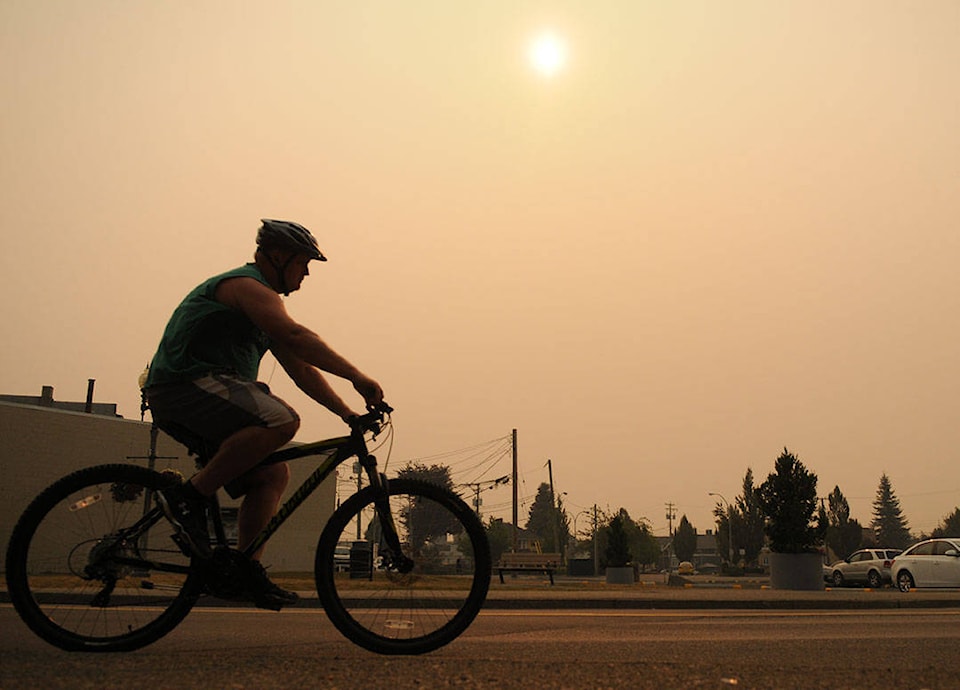What is in wildfire smoke?
Wildfire smoke is a complex mixture of particles and gases containing hundreds of chemicals. The smoke contains large amounts of fine particulate matter, as well as gases such as carbon monoxide, carbon dioxide, and nitrogen oxides. Depending on the type of materials burned, the smoke may also contain sulfur oxides, volatile organic compounds, and other compounds such as hydrocarbons and formaldehyde that are known to be carcinogenic.
What are potential health effects?
There are a number of potential health effects associated with wildfire smoke. Inhaling fine particles of smoke has been linked with the aggravation of pre-existing respiratory and cardiovascular disease.
Exposure to wildfire smoke may raise concerns about long-term health effects, such as an increased risk of cancer or other chronic health problems. In general, however, the long-term health risks from short-term exposure to low or moderate levels of smoke during a wildfire event are considered to be quite low.
What are common symptoms of smoke exposure?
Breathing in smoke can cause irritation of the eyes, nose, and throat. It can also cause headaches and worsening of allergies. In healthy people exposed to smoke for short periods of time, symptoms are likely to be temporary and will resolve when the smoke clears.
People with lung diseases such as asthma or chronic obstructive pulmonary disease (COPD) as well as other chronic diseases, pregnant women, and older adults, are likely to experience more serious or acute symptoms. These symptoms can include shortness of breath, persistent coughing, wheezing, chest tightness, and increased mucous production.
Be aware of other health issues related to wildfires, such as heat stress or heat exhaustion, and the need to stay hydrated by drinking lots of water. In addition, there may be other safety hazards associated with wildfire smoke, such as reduced visibility.
Reduce the level of physical activity when possible, since physical exertion can increase air intake as much as 20 times.
Can I reduce the exposure to smoke indoors?
Smoke conditions and local air quality can change due to the unpredictable nature of fires and changing wind conditions. But there are actions you can take to reduce the health effects of smoke in the air:
• Some individuals may be more sensitive to the effects of smoke from forest fires, such as those with heart or lung conditions. These individuals should watch for any change in symptoms that may be due to smoke exposure. If symptoms are noted, reduce exposure to smoke and seek medical attention.
• If your breathing becomes difficult or uncomfortable, stop or reduce the activity.
• Stay cool and drink plenty of fluids.
• Smoke levels may be lower indoors, however levels of smoke particles will still be increased. If you stay indoors, be aware of your symptoms.
• Consider visiting a location like a shopping mall with cooler filtered air. Keep in mind that staying indoors may help you stay cool and provide some relief from the smoke. However, many air conditioning systems do not filter the air or improve indoor air quality.
• Reduce indoor pollution sources such as smoking or burning other materials.
• You may be able to reduce your exposure to smoke by moving to cleaner air. Conditions can vary dramatically by area and elevation.
• Residents with asthma or other chronic illness should activate their asthma or personal care plan.
• Pay attention to local air quality reports, air quality may be poor even though smoke may not be visible.
• Commercially available HEPA (high efficiency particulate air) filters can further reduce poor indoor air quality near the device.
• Inspect the HVAC system in your home and workplace to make sure it is working properly.
• Check air filters to ensure they are clean and are not damaged, dislodged, or leaking around the edges. If the system is capable, replace the filters with higher efficiency filters for the duration of the wildfire event.
• Reduce indoor particle levels in small areas by using individual portable air cleaners equipped with HEPA filters or electrostatic precipitators.
What precautions are specific to vehicles?
People travelling in vehicles are advised to keep vents and windows closed and, if available, operate the air conditioning in “recirculate” mode. However one should also open the windows occasionally in areas with good air quality to prevent carbon dioxide from building up inside the vehicle.
One should also consider the potential for heat stress or heat exhaustion, as well take precautions against the hazards of driving in low-visibility environments (e.g., drive with lights on, do circle checks).
Should respirators be used?
In some circumstances, personal protective equipment such as respiratory protection may be necessary when exposed to moderate to high levels of smoke and depending on the level of activity. The most common type of respirator used to protect against wildfire smoke exposure is the N95 particulate-filtering facepiece respirator. For those who require more advanced protection against fine particulates and irritant gases and vapours, elastomeric respirators (both half-face and full-face types) fitted with a combination of organic vapour cartridge/P100 filter are more appropriate.
Note that masks are not substitutes for respirators. A mask refers to something like a surgical mask that is loose fitting and does not form a tight seal with the face. These masks are not designed to filter the fine particulates or gases and vapours in smoke.
Workplace regulations?
The Occupational Health and Safety (OHS) regulation does not provide specific requirements for wildfire smoke. However, you must treat this hazard in a similar manner as other general workplace hazards. The Workers Compensation Act and Regulation specify the requirements for employers to ensure the health and safety of workers in all work. For more information contact HealthLink BC toll free, 24 hrs, 7 days a week at 8-1-1.
See www.bcairquality.ca. for more information
- with files from WorkSafeBC and Interior Health
